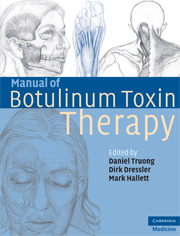Book contents
- Frontmatter
- Contents
- List of contributors
- Foreword – Alan B. Scott
- Preface
- 1 The pretherapeutic history of botulinum toxin
- 2 Botulinum toxin: history of clinical development
- 3 Pharmacology of botulinum toxin drugs
- 4 Immunological properties of botulinum toxins
- 5 Treatment of cervical dystonia
- 6 Treatment of hemifacial spasm
- 7 Treatment of blepharospasm
- 8 Treatment of oromandibular dystonia
- 9 Treatment of focal hand dystonia
- 10 Botulinum toxin applications in ophthalmology
- 11 Botulinum toxin therapy of laryngeal muscle hyperactivity syndromes
- 12 The use of botulinum toxin in otorhinolaryngology
- 13 Spasticity
- 14 The use of botulinum toxin in spastic infantile cerebral palsy
- 15 Hyperhidrosis
- 16 Cosmetic uses of botulinum toxins
- 17 Botulinum toxin in the gastrointestinal tract
- 18 Botulinum toxin in urological disorders
- 19 Use of botulinum toxin in musculoskeletal pain and arthritis
- 20 The use of botulinum toxin in the management of headache disorders
- 21 Treatment of plantar fasciitis with botulinum toxin
- 22 Treatment of stiff-person syndrome with botulinum toxin
- 23 Botulinum toxin in tic disorders and essential hand and head tremor
- 24 Developing the next generation of botulinum toxin drugs
- Index
- References
20 - The use of botulinum toxin in the management of headache disorders
Published online by Cambridge University Press: 28 July 2009
- Frontmatter
- Contents
- List of contributors
- Foreword – Alan B. Scott
- Preface
- 1 The pretherapeutic history of botulinum toxin
- 2 Botulinum toxin: history of clinical development
- 3 Pharmacology of botulinum toxin drugs
- 4 Immunological properties of botulinum toxins
- 5 Treatment of cervical dystonia
- 6 Treatment of hemifacial spasm
- 7 Treatment of blepharospasm
- 8 Treatment of oromandibular dystonia
- 9 Treatment of focal hand dystonia
- 10 Botulinum toxin applications in ophthalmology
- 11 Botulinum toxin therapy of laryngeal muscle hyperactivity syndromes
- 12 The use of botulinum toxin in otorhinolaryngology
- 13 Spasticity
- 14 The use of botulinum toxin in spastic infantile cerebral palsy
- 15 Hyperhidrosis
- 16 Cosmetic uses of botulinum toxins
- 17 Botulinum toxin in the gastrointestinal tract
- 18 Botulinum toxin in urological disorders
- 19 Use of botulinum toxin in musculoskeletal pain and arthritis
- 20 The use of botulinum toxin in the management of headache disorders
- 21 Treatment of plantar fasciitis with botulinum toxin
- 22 Treatment of stiff-person syndrome with botulinum toxin
- 23 Botulinum toxin in tic disorders and essential hand and head tremor
- 24 Developing the next generation of botulinum toxin drugs
- Index
- References
Summary
Summary of clinical aspects of headache disorders
Headache affects over 45 million individuals in the United States, which makes it one of the most common nervous system disorders (NINDS, 2002). The International Headache Society (IHS) classifies primary headache disorders as those in which headache itself is the illness, with no other etiology diagnosed. Examples include migraine and tension-type headache (TTH) (IHS, 2004). Headache disorders can be further classified as episodic (< 15 headache days per month) or chronic (≥ 15 headache days per month for more than 3 months) (IHS, 2004).
Migraine is a progressive debilitating disorder characterized by enhanced sensitivity of the nervous system (Silberstein, 2000); it is associated with a combination of neurological, gastrointestinal, and autonomic disturbances (Silberstein, 2004). The IHS diagnostic criteria for this condition includes headache associated with at least two of the following: unilateral location, pulsating quality, moderate or severe pain intensity, and aggravation by or causing avoidance of routine physical activities; at least one of the following during headache: nausea and/or vomiting, photophobia, and phonophobia; and headache not attributable to another disorder (IHS, 2004). It is estimated that 28 million Americans, including 18% of women and 7% of men, are afflicted with severe, disabling migraines (Lipton et al., 2001). The World Health Organization (WHO) ranks migraine as one of the world's most disabling illnesses, profoundly impacting quality of life, causing functional impairment, and disruption of household or social activities (WHO, 2004).
- Type
- Chapter
- Information
- Manual of Botulinum Toxin Therapy , pp. 175 - 184Publisher: Cambridge University PressPrint publication year: 2009

